Akron Phy sics Club
Archive 2019
~~~~~~~~~~~~~~~~~~~~~~~~~~~~~~~~~~~~~~~~~~~~~~~~~~~~~~~~~~~~~~~~~~~~~~~~~~~~~~~~~~~~~~~~~~~~~~~~~~~~~~~~~~~~~~~~~~~~~~~~~~~
Newsletter
Meeting Announcement: MONDAY, January 28, 2019 - TANGIER, 6:00 PM
Dr. Veronica Dexheimer, Assistant Professor, Department of Physics, Kent State University
will be speaking on:
Neutron Stars: a laboratory of exotic matter
Abstract:
As the density of matter increases, atomic nuclei disintegrate into nucleons (protons and neutrons) and, eventually, the nucleons themselves disintegrate into a different phase of matter made of deconfined quarks. Although it is impossible to reproduce these densities in laboratories here on Earth, they naturally exist in the cores of neutron stars. The phase transitions between these different phases of matter can leave fingerprints in stellar properties than can be observed. More specifically, mergers of neutron stars in binary systems produce gravitational waves that have the potential of revealing these new phases of matter. I will present the first fully general-relativistic simulations of merging neutron stars including quarks. Within this approach, we can determine clearly what signatures a phase transition to quark matter would leave in the gravitational-wave merger signal and what we will be able to learn from future measurements.
Bio:
Dr. Veronica Dexheimer is a theoretical astrophysicist. She specializes in the study of dense and hot matter, such as that present in neutron stars during different stages of their evolution. She obtained her Bachelor’s and Master’s degrees from Universidade Federal do Rio Grande do Sul, in Brazil, in 2003 and 2006 and her PhD from the Johann Wolfgang Goethe University, in Germany, in 2009. She has been working as an Assistant Professor at Kent State University since 2013, where she is the leader of the Nuclear Astrophysics group and Vice Director of the Center for Nuclear Research.
Minutes, January 28, 2019
Our Chairman Bob Erdman brought the meeting to order.
The first announcement was the confirmation that our Tangier dinner price did increase by $2 per plate. But that is the first increase we have had in several years. Tangier still provides us with great meeting accommodations (dinner & room).
Our Treasurer Rick Nemer reported that we have 23 members at this meeting. 21 had dinner and 2 came just for the meeting. Our starting account balance was $379 and our ending balance was $409, but $264 of that is set aside for student dinner sponsorship.
We welcomed Eian Abbot and Ed Gorski, along with Mark & Karla Schmiedlin from the Cleveland Astronomical Society. Nice to see you again.
Our program Chair Dan Galehouse thanked Gary Catella for helping out while he was in Hawaii for a physics symposium. Dan’s favorite topic there was weak interactions and the missing terms of the Dirac equation (the relativistic free-form wave equation derived in 1928).
Dan Galehouse mentioned that in February Hunter King will speak to us about biomedics, Bruce Taylor in April on heart assist pumps, and our own Bob Erdman in June. There is also a semi commitment from John Kirszenberg to speak on the current flat Earth movement come September.
Gary Catella gave us an update on the fusion laser experiments at Lawrence Livermore. Gary mentioned that last month they had an increase in the amount of the energy absorbed by the target. They got 300 kilo-joules of ultraviolet absorbed in the inner target from only 1 mega-joule in. An improvement of a factor of 2-1/2.
Our Secretary and web master John Kirszenberg announced that our local science fairs needs judges for upcoming events:
* March 16th university of Akron competition
* Cleveland State University has one need judge, by invitation only
Notes on Dr. Veronica Dexheimer’s presentation:
Neutron Stars: a laboratory of exotic matter
Bob Erdman then introduced our guest speaker for tonight, Dr. Veronika Dexheimer, Assistant Professor, Department of Physics, from Kent State University.
Dr. Veronica Dexheimer is a theoretical astrophysicist. She specializes in the study of dense and hot matter, such as that present in neutron stars during different stages of their evolution.
She obtained her Bachelor’s and Master’s degrees from Universidade Federal do Rio Grande do Sul, in Brazil. In 2009 she obtained her PhD from the Johann Wolfgang Goethe University, in Germany. Today she is the leader of the Nuclear Astrophysics group and Vice Director of the Center for Nuclear Research.
We welcomed Dr. Dexheimer with a hearty round of applause, and thanked her for coming today.
Dr. Dexheimer mentioned right off the bat that she was here to talk about her favorite topic, neutron stars.
Enthusiastically she said, “So let’s start with a historical overview of how did we come to know about neutron stars.”
Our first record of a supernova explosion was of a Chinese naked eye sky siting in the year 1054. Since then we have come to know this as the Crab Nebula.
In 1931 the Soviet scientist Lev Landau conjectured about the atomic nucleus. He thought, “There is a lot of empty space, with electrons and protons and neutrons. What about if we could have a giant nucleus?”
But the problem is, when you have too many protons they don’t want to be next to each other because of the coulomb repulsion. And it’s impossible to make a nucleus that’s too big; there is a maximum size. But what if somehow we did have a giant one. But for that to work the laws of ordinary quantum mechanics would have to break down. And that was a terrible thing to say in the beginning of the last century, because quantum mechanics was booming then. So his article was buried. And it was only found a few years ago.
And a year later the neutron was discovered by British physicist James Chadwick, and then it all made sense, because the atom had many more neutrons which are charged neutral in a giant nucleus and that would be ok. So it all worked out.
So then the science community agreed that neutron stars could exist, with a giant nuclei.
A few years later in 1939 a connection was made, that perhaps a supernova explosion leaves behind a neutron star. Baade and Zwicky proposed that heavy stars explode as supernovae and thusly give birth to neutron stars.
A supernova explosion itself occurs for only minutes, but the fading light curve can continue for a few weeks.
The first observation of an extragalactic supernova (in the Andromeda Galaxy) was recorded on August 17, 1885, by French astronomer Ludovic Gully, during a public stargazing event. However, at that time is was not recognized that the Andromeda Nebula was an actual galaxy, like our own Milky Way, and much much further away than thought.
The most recent supernova to be seen in our Milky Way galaxy was SN 1604, which was observed October 9, 1604. Since we expect to have one about every century, way may now be past due.
Neutron stars are often referred to as pulsars.
The first pulsar was observed in a radio frequency by Jocelyn Bell in 1967: LGM-1. She was a PhD student at the time. She measured radio signals from space. She found a signal which was very precise. People thought that was weird. She was told “it’s probably a problem in your equipment.” She re-checked several times but came up with the same result. Her advisor then checked it out and because convinced that Jocelyn did indeed find something.
By the way, LGM-1 stands for (Little Green Men – 1)
As its name implies, a pulsar is a star that give off “pulsates” at a regular precise timed interval. This is sometimes called the “light house effect.”
About the light house mechanism - Neutron stars rotate, so they have an axis of rotation. But the thing is that their magnetic field axis is not aligned with their axis of rotation. The earth’s magnetic field is nearly aligned (off only 500-km) with the rotational axis. But in stars, all kinds of stars, can be even more different. So when it rotates, it emits light like a lighthouse.
So if you are in a direction where the beam passes by you, you see it pulsating. Pulsing very fast. More than once per second. The fasted one observed is more than 600 times per second. But if you’re not lucky to be in that direction you don’t see it. So pulsar is called the ones that we see it thru this mechanism. Otherwise it’s called a normal neutron star.
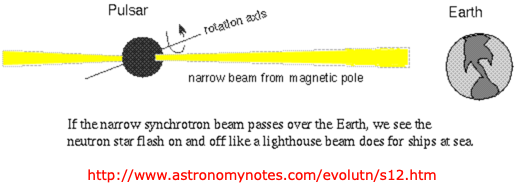
We have discovered thousands of them since the 60’s. It’s easy to measure the surface temperature and how fast they are rotating. Easy to measure the mass if in a binary system which many of them are. But other things are not. It’s much more complicated to find out about surface magnetic fields, and their radii.
Dr. Dexheimer pointed out that most of the things that she listed here don’t tell us anything about the inside of the star, which is what she is very interested in. There might be a new kind of matter inside the star. The only thing we can calculate is, dividing the mass by the volume, we can calculate an average density.
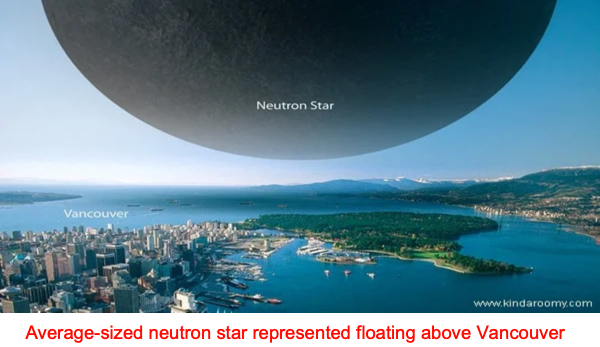
So how does a neutron star come into being?
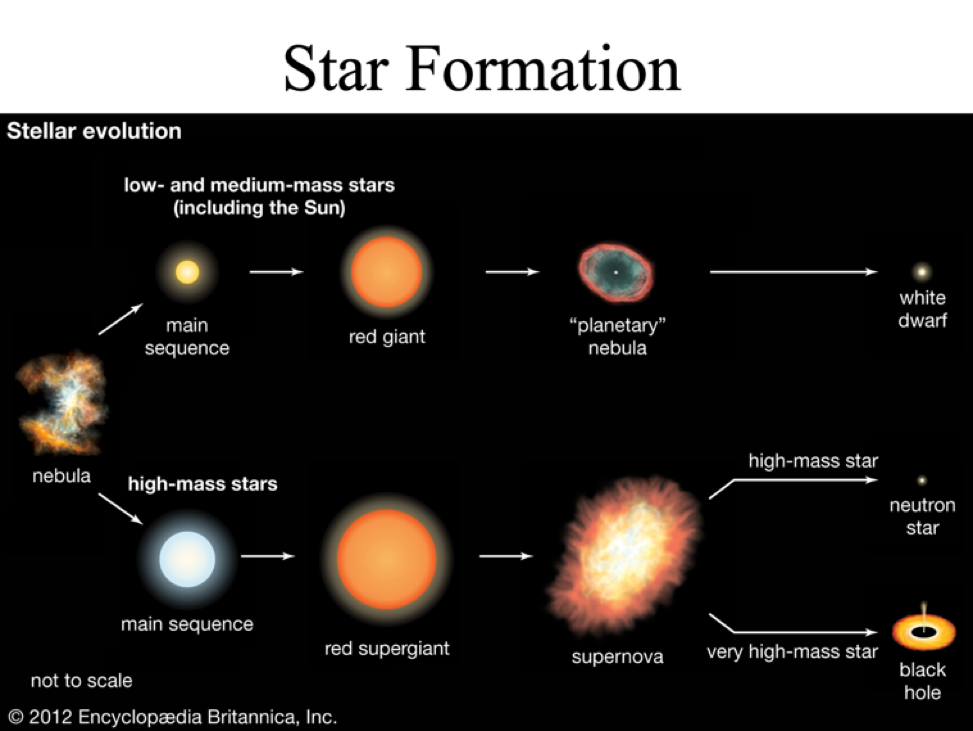
It starts with a Hydrogen and helium cloud. For most of their lives they are on what’s called the main sequence, where the Sun is right now, doing fusion from Hydrogen into Helium. When it starts burning helium they get bigger. That’s very important for us. When the Sun does that it will greatly enlarge and swallow the Earth. But eventually stars like the sun will lose most of their mass and become white dwarfs.
Neutron stars are formed by more massive stars. At least about 10 times the mass of the Sun, and they get much more giant and then explode. If they are too large, like more than 50 times the mass of the Sun, they become black holes, otherwise they become neutron stars.
Neutron stars are exotic also, but we estimate what’s inside all the way down to the center.
The average nuclear density of a neutron star is 1015 g/cm3 That is also the average density of an atomic nucleus. Remember that the average density of water is only 1. So this is more than a quadrillion times the density of water.
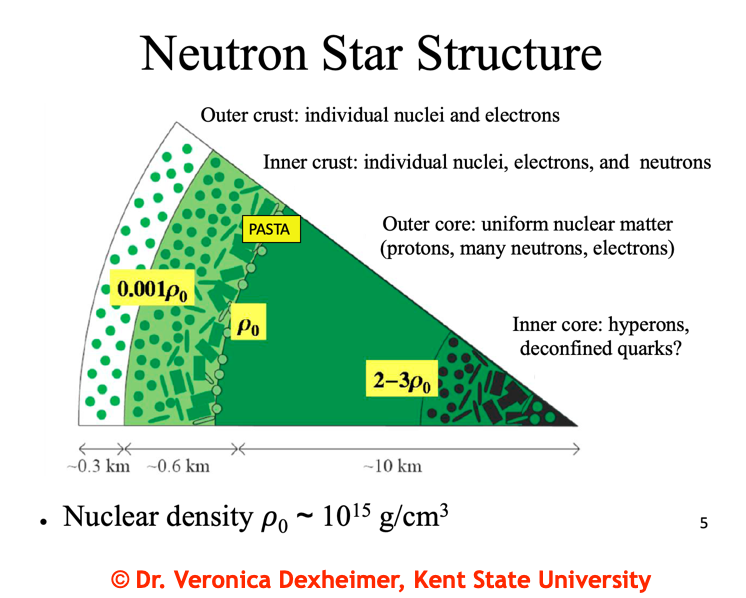
A neutron star has mainly a crust and a core. After you pass the density of the nucleus, there is no empty space anymore. It’s like having nuclei touching each other. So they kind of dissolve into their constituents. Then we have what is called hadronic matter, which is a soup of protons and neutrons and electrons. Any maybe more interesting things as you go inside. There are other particles like heavy protons called hadrons. Since proton and neutrons are made of quarks, if you keep pushing maybe you end up with a soup of quarks also.
So the neutron star is about the size of a 12-km city. But the core is about 10-km.
The most common hadrons are the protons which have two up quarks and a down. The neutron has two down and one up. And you can have “strange quarks” inside which are heavier. Hyperion is a name for hadrons that have at least one quark inside.
We know that hyperons exist since we can produce them in a lab, even though they last for a very short time. The hypothesis is that if we keep pushing protons and neutrons and hyperons together, since they are made of quarks, at some point we have a soup of quarks inside.
Dr. Dexheimer explained, that she and others have also developed several models to better help us understand the interiors of neutron stars. The overlap of large matter densities and quarks are what we call de-confined – emphasis on the possible existence of quark matter in the cores of rotating neutron stars (pulsars). In contrast to non-rotating neutron stars, whose particle compositions do not change with time (are frozen in). The type and structure of the matter in the cores of rotating neutron stars depends on the spin frequencies of these stars, which opens up a possible new window on the nature of matter deep in the cores of neutron stars.
A few years ago Dr. Dexheimer started to think about where would neutron star mergers go, because she said that many neutron stars are in binary systems. So what about if the merge - should be very hot and dense? So she put this bubble here (see diagram below) for neutron stars. Finally, last year she managed to get a better estimate of how hot and dense this would be.
The following phase diagram for high energy shows our model for the atomic and possible quark phases for merging neutron stars, supernovae, and neutron stars themselves.
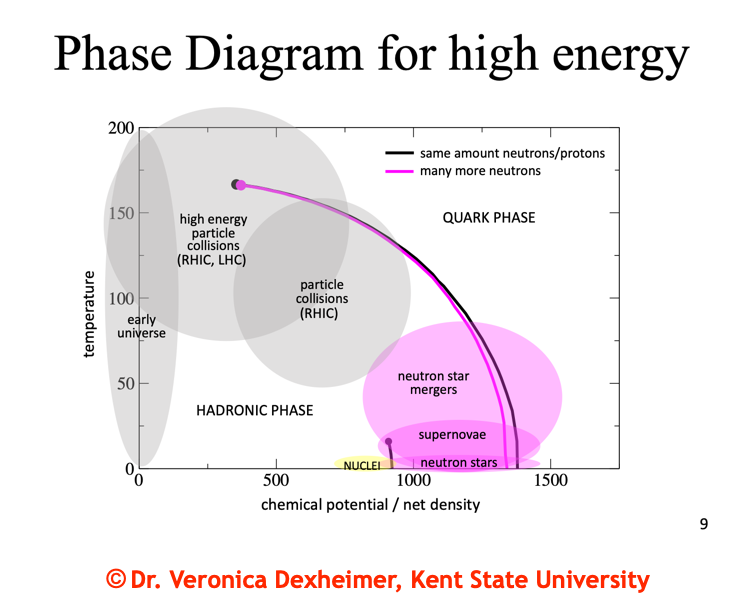
We know that supernovae are even hotter. Matter can also go a little bit into the crust, the core, and the quark phase at the very center.
So what is the particle population with respect to neutron star radius?
It’s nice to hypothesis (since we can’t directly measure this as of today) but as she said before, we cannot look into the center of a star. We measure things from the surface, like temperature, but not the inside. We just have a vague idea about an average density. So how are we going to prove that the quarks are there or not?
So now we will go the other way, kind of the same but starting with protons and electrons, muons and lambda, and that’s where the quarks appear here. We have again down and up, and the stars in our model are not dense enough to get strange quarks. But with quark matter we are talking about 2 kilometers (u is up quark, d is down quark).
What about neutron star rotation (we can’t directly measure this as of today)?
All stars rotate in the same way that planets rotate. When rotation is involved things get complicated. For example, even the Earth is already bulging because it rotates. These things (neutron stars) rotate at hundreds of time per second, so they are very bulgy. So we have to get rid of the equation I just showed you, and use some slightly more complicated ones to calculate things. Think about getting a bucket of water or anything that is fluid and rotate it very fast. What happens? It spills, right? So if the stars rotate too fast the same thing happens. Matter starts being expelled out. We call this “shedding frequency.”
So for this particular star the shedding frequency will be about 1,000 rotations per second. The fastest one we have measure SO FAR is 600. What we also learn from the bucket of water example is as stuff comes out as you are rotating faster and faster, it gets less dense in the center. That happens here too. When something rotating too fast their center density is low, and then as quarks lose energy, they radiate light. As I am going to talk about later they also emit gravitational waves and they start rotating slower. So as they slow down the density now increases to bring hyperons in the center and hopefully enough to create quarks.
The idea here is that quark matter does not have to exist in young stars, but probably exists in stars that are older. Neutron stars live for million and millions of years. Until they die and no light comes from them anymore.
So as recently as September 2015, a new window opened up in the universe, the detection of gravitational waves. So naturally we think, can we leverage this to study the interiors of neutron stars.
Gravitational waves are disturbance due to massive objects that transfer energy through matter or empty space, with no mass transport. They are oscillations of the space-time fabric around fixed locations. And the waves travel at the speed of light.
Gravitational waves were predicted by Einstein in 1916. In 1962 building the first interferometer to measure them was proposed. LIGO was built in 2002 but no gravity waves were detected. In 2015 multiple upgrades to LIGO were completed, and in 2015/2016 LIGO detected the first gravity waves from the merger of two black holes. In 2017 gravity waves were detected from the merger of two neutron stars.
But we are still looking for a black hole and a neutron star merger. We can also have a white dwarf and a neutron star merger. There are several combinations that people speculate that can exist.
Gravity waves are very hard to measure. The waves changed the interferometer 4-km LOGO arm length by a thousandth of the width of a proton.
Dr. Dexheimer pointed out, that when two neutron stars merge they become a black hole.
As they get close to each other they deform. The signal (amplitude of strain) indicates how deformed they are and is used to calculate the radius. The merger gets super dense and for sure produces quark matter. And black hole mergers take place faster than neutron star mergers.
We then we saw a nice movie that simulated the mergers of two neutron stars.
As neutron stars’ merge, a hot ring with some quarks form around the center. They a very hot region forms in the center with lots of quarks.
You may ask, can isolated stars like our sun emit gravitational waves? The answer is yes, if they oscillate asymmetrically (having two sides or halves that are not the same)
So in conclusion …
Astrophysics provides an ideal testing ground for nuclear and particle physics.
Specially for high density environments inside neutron stars that particle colliders cannot access.
Maybe the detection of de-confined quark matter will come from astrophysics!
Now, in addition to observe light, we can also understand the universe through gravitational waves
We gave Dr. Dexheimer a huge round of applause for sharing her ground breaking and intriguing research with us.
John Kirszenberg, Secretary
~~~~~~~~~~~~~~~~~~~~~~~~~~~~~~~~~~~~~~~~~~~~~~~~~~~~~~~~~~~~~~~~~~~~~~~~~~~~~~~~~~~~~~~~~~~~~~~~~~~~~~~~~~~~~~~~~~~~~~~~~~~
Newsletter
Meeting Announcement: MONDAY, February 25, 2019 - TANGIER, 6:00 PM
Dr. Hunter King, Assistant Professor, Department of Polymer Science, Department of Biology, University of Akron
will be speaking on:
Transport problems solved by insects
Abstract:
Extraction of clear lessons from biological systems is far from straightforward, as field work is messy and simple physical principles can be obscured by complexity. Three stories toward this end will be presented: 1) a termite mound, which harnesses an unusual source of energy to drive colonial respiration; 2) a Fijian epiphyte which has morphologically evolved to accommodate the thermal needs of its ant inhabitants; and 3) a popularized desert beetle which derives moisture from the atmosphere by controversial means.
Short bio:
Hunter King is an experimental soft matter physicist. Prior to joining UAkron as assistant professor of Polymer Science and Biology through the Biomimicry Research and Innovation Center, he was a postdoc in the School of Engineering and Applied Sciences at Harvard University, where he investigated mechanical phenomena in biological systems, focusing mostly on the mechanism of passive ventilation inside termite mounds. He completed his PhD in physics at UMass, Amherst, where he worked on mechanics of disordered media and instabilities in thin sheets at liquid interfaces.
Minutes, February 25, 2019
Our Chair Bob Erdman called the dinner to order. He mentioned that we have a short business meeting before the speakers presentation.
Our Secretary John Kirszenberg was called upon to share announcements with us. John pointed out that as a personal board trustee and member of the Cleveland Astronomical Society (CAS) all of our Physics Club lectures are also announced at their meetings. As a reciprocal courtesy - on March 7th, Dr. Barbara Ryden of Ohio State University will be presenting “Dark Energy and the Accelerating universe” at CAS. Well worth attending. For reference, the entire CAS lecture series is present on our web site.
Our Program Chair Dan Galehouse was not present so our upcoming, as listed on our web site was enumerated:
March 25th Chris Cole, Introduction to Machine Learning (AI)
April 22nd Dr. Bruce Taylor, Mathematical and Computer Modeling of the Circulatory System
June 3rd, Chair Bob Erdman, Real and Ideal Electronic Measuring Instrumentation
Treasurer Rick Nemer reported that 16 people were in attendance today. Our ending monetary balance is $435 (which contains $254 earmarked for students).
Our Vice-Chair Darrell Reneker then introduced todays speaker. Darrell has worked with Hunter in the past, and emphasize that Hunter considers himself to be an “Experiment Soft Matter Physicist.”
Notes on Dr. Hunter King’s presentation:
Transport problems solved by insects
Dr. Hunter King thanked everyone for the opportunity to speak today…
“Thanks for having me here. I know it’s a physics club but you have also had speakers that talk around things that are somehow related to physics. I could say I ended up in a position to be talking about insect by mistake. I never saw the appeal working on biological things because they are just too complicated to think about really, but I got into it pretty much due to bait and switch in post doc position. I was going to be doing some similar mechanical instability things. My post doc advisor said great, but I have money to work on termites.”
Dr. King mentioned that today’s talk was going to cover termite mounds, ant symbiosis plants, and an interesting Namibia beetle that learned how to capture water from the air.
All three are related to each on the topic of insect transport. Our lecture approach will address, what problem are these structures trying to solve, and what is the underlining functional principle. Let’s look at these biological systems and extrapolate what we can learn about their transport, and how possibly could this be applied for human purposes.
To start let’s look at two different termite species and mounds, one in India and the other in Africa that we examined.
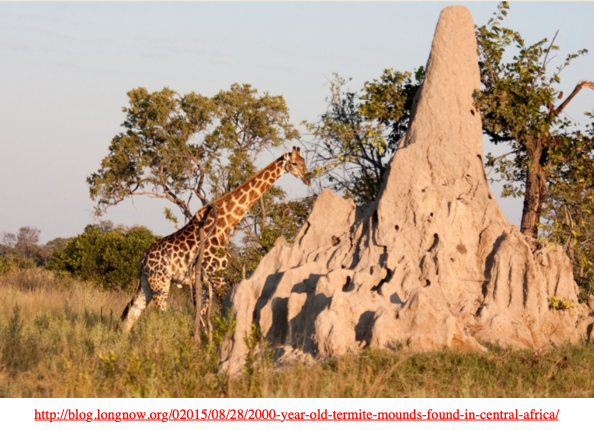
Dr. King explained that termite mounds are different based upon the species that created it, and the location/climate. Some are a couple meters tall while others are many meters tall. It’s a large structure, and you immediately wonder why and how was it built. Consider that they are built by termites which are really tiny insects.
A first obvious question to ask is why do they make it so big, and then of course if you think about it, being scaled to the size of humans, termites are much smaller than we are, which correspondingly ends up being the same size as the largest thing WE have ever built.
Why so big, because when you break it open there is nothing, it’s just pretty much open space. You might see one termite patrolling every once in a while but that is it. There is nothing there. You have to dig underground to find the nest and the termite activity.
Our speaker pointed out that the nest associated with the mound has lots of termites, on the order of millions, or hundreds of thousands. They are busy cultivating fungus. And then there is the royal family and what they do.
But why such a large mound when they are all basically in the nest? But let’s put that aside for a moment to talk about how they make it.
The way they make this large structure is by individually depositing a little pellet of soil. They spit it out of their mouth and they go and eat some more, adding a lot of water. The whole structure is made out of tiny pellets. But they do this on such a large scale using all of the workers is such a way that they actually make a structure. What makes this more incredible is that termites are blind and can only sense local things that are going on. There is no central decision making authority. The behaviors are all swam like. They are individually not very smart but yet we have this huge scale response of many individuals coordinated. They are somehow aware when part of the mound is broken, and they go to fix it.
It’s useful to think about this system in the context of this concept of a super organism. The individual termite not being the organism being pushed by natural selection, but rather the whole colony around it. And that means you have specialization of the different components. The King and Queen are just the reproductive organs. The fungus plays the role of our human gut floral. Termites collect a lot a plant material but it’s not complete nutrition. The fungus does the remainder of the work.
Dr. King stated that he looked at the mound from several perspectives to understand what purpose I could be serving.
One perspective to better understand the overall construction is to fill up the mound with plaster and wash out the material. And you see the whole thing is standing upright, which means it’s all connected, and mostly air on the inside.
Looking at the mound from above it seems a lot of this structure is made up of these buttresses called flutes, and if you chop it in half you see that some of these conduits are very broad and vertical on the edges, and then a large conduit in the center that called a chimney.
Now this doesn’t help understand what these are for. But you have this nest and all these metabolic parts that are underground that has the metabolic activity of a goat.
The idea that has been around for a while is that the mound somehow facilitates respiration.
But how does that work since there is no elasticity or change of shape to drive the flow? And there is no clear inlet and outlet.
Dr. King reminded us that there are two steps for ventilation to be able to happen on this scale. There has to be some form of bulk transport, because it’s got to come a large distance, from the metabolic activity to the rest of the mound, and there has to be some way of getting out of the mound.
So it’s fairly easy to think of the second one first – how to actually exchange with the environment. We see that the material is very pours, but the pours are small. And the consequences of that are that you have a material that is very impermeable to pressure driven bulk flow, but it’s got a lot space for diffusion. So molecules can just leak in and out easily because of that open-space but can’t actually force the air through.
So the walls are permeable but what gives us transport is a little bit more of the mystery. There is a bit more controversy involved in this.
The old theory since the 60’s was that the mounds function primarily as an air conditioner. You have this large metabolic mass underground (the nest) that would be heating up too much. That’s bad for insect’s since they like the temperature to be constant. So you have this convective cell that’s driven by metabolic heating, and then as the air circulates around, you end up exchanging with their environment and cooling down. That solves the respiration and heating problem. And there is also some indirect evidence for this looking at the CO2 level in different locations.
A collaborator of Dr. King noticed that the nest itself was not warmer than the other parts of the mound, and that the nest is not warmer than another part at the same level. So it couldn’t be driven by metabolic activity. So metabolism is not affecting temperature and that can’t be what is going on.
So you end up putting together a different theory. Well, we still need some kind of bulk flow but that’s going to come from some other source. The proposal was the wind on the outside. And not just the direct wind but some fluctuations in the wind. You get these sort of temporary differential pressures that drive some flow thru.
To study this some tracer gas was injected into some parts of the mound and then he recorded how it cleared over time.
“We then wanted to directly measure the flow so we built an anemometer ourselves,” Dr. King noted. An anemometer is an instrument that measures wind speed and wind pressure. In the field we would have to keep rebuilding the sensor and recalibrating it. We could have a metric related to the flow. So we built it and wanted to look at some mounds in India (in moist environment with indirect sun) and some in Namibia, Africa (in full sun, near desert area).
Sensors were put in the surface conduit where we knew the geometry was quite similar. In Africa there was a lot more transient behavior, while in the Indian mounds there was just a steady flow. Within the steady flow signal we found a trend based on the hour of the day, strongly downward at night and weakly upward during the day.
We then measured the temperature near the surface conduits and the chimney to see what the temp variation during the days was. The structure itself is taking advantage of the diurnal oscillations of external temperature. By virtue of being a large heavy object it does not come to equilibrium at the same time.
So as long as day and night have different temperatures, there will be a gradient between inside and outside of the chimney. And since the structure involves conduits that connect the nest with the internal bits, then you always have a convective cell.
In Africa this upward/downward flip was twice a day (2nd downward less pronounced), while in India it was once a day.
But is this serving some biological function also? To check that we wanted to see what the CO2 in the mound was doing. We thought we would see a low concentration of CO2 in the nest as the system was running, but because it has to flip over twice a day we have two stagnation points.
In India it didn’t look like that. Instead during the day there was this huge increase of stagnation in the nest, and then as the thermal inversion happened we saw the chimney CO2 jump up and then the two values went down together.
So that is the story on our termite research. Now as let’s look at another interesting insect phenomenon.
There are plants in Fiji called Squamellaria. They have mutually beneficial relationship with ants; food for shelter. Worker ants harvest seeds from their epiphytic homes, carry them away, and then insert them into cracks in the bark of suitable trees. That done, they patrol the sites of the plantings to keep away herbivores, and also fertilize the seedlings as they grow by defecating into hollow structures called domatia that develop in the bases of the plants’ stems.

This is the only known obligate mutualism between an ant and a plant. Neither of these two species can live without the other. They are symbiotic to the point of being completely dependent. Ants plant and tend/guard the seeds, while the plant feeds the ants sugar and makes a structure they can live inside of.
In this relationship there are two types of ants, the specialist and generalist. Specialists are way up high in the trees, and the generalists down below.
Dr. King told us that high up plants get more sunlight and therefore make more sugar. So this is a good reason for the ants to put the seeds way up high. But up there it heats up a lot, and that is very bad for ants.
The specialist housing protrudes way out into the environment, while generalist housing is stuck close to the tree. Specialists have much less body hair while the generalists have more. That is no doubt related to the different temperature (re: convection and conduction) conditions above the tree and below.
As guessed there are morphological differences due to heat transfer. Specialists are way more coupled to the air and also very sensitive to the sun. The specialist structure inside has a large variation in temperature. Specialists have a structure that is softly coupled to the outside, but has a lot of variation on the inside. This structure has lots of options. You can carry your brood around inside to where the temperature is better for them.
For the generalist the housing walls are more woody and thicker. Dr. King cited that we are still continuing our research on these interesting insects.
Our next topic is also quite interesting, and concerns how beetles capture water from airborne fog. Wow. Nature is certainly magnificently diversified and adaptive.
Fresh water scarcity is a growing problem all over the world. But our atmosphere contains a lot of moisture that can be tapped using cleaver techniques, particularly when either in the form of vapor or fog.
Today vapor water capture is via condensation and network heat transfer. Fog water capture is via droplet interception coupled with fluid dynamics.
In the desert water exists just above the surface in air droplets that are too small to fall. But an ingenuous beetle has figured out a way to capture it from the air.
Darkling beetles (Tenebrionidae) go up to the tops of dunes, lean into the wind, and collect the fog moisture on their back that forms into droplets, and then they drink it.

Tiny sized grooves or bumps on the beetle’s hardened forewings can help condense and direct water. A combination of hydrophilic (water attracting) and hydrophobic (water repelling) areas foster dew-harvesting efficiency. And it’s thought that the act of facing into the foggy wind and sticking its rear end up in the air (known as fog-basking behavior) is just as important as body surface structure for successfully harvesting water from the air.
From a physics standpoint we need to understand the three efficiencies involved in successful water collection using this method:
The three efficiencies:
a) for the air to actually go thru the object. Want a lot of surface area to make the interception, but not so much the flow is diverted around it.
b) the impaction efficiency of this droplet’s headed toward one of the fibers, an efficiency of making a collision. Depends on Stokes number
c) draining efficiency. If it gets clogged, then it does not work.
Is there anything we can do to collect more water? You can’t become the shape of a mesh which is obviously better but perhaps you can do something about your surface morphology to collect more water.
Impaction efficiency depends upon the inertia of the droplet. The higher density is not going to be able to make the same turns as the fluid that its suspended in, so every once in while you have a collision. And that is pretty easily quantified for smooth shapes.
But is there something you can do on a tiny scale to encourage these collisions a little bit more? That’s the sort of thing that would be available to the structure of a beetle for instance.
So these beetles have bumps on them. Dr. King conveyed that we built a wind tunnel for testing our 3D printer replication of the beetle. We know how much fog is going thru and what percent was actually caught by the target. We can get a robust accumulation rate from this and relate it only to the surface morphology.
When going across a bumpy surface the efficiency jumps up by a factor of three, as compared to smooth.
There is still much more room for investigation into how the beetle collects the fog.
Dr. Hunter then ended the talk and answered some questions.
We thanked Dr. Hunter with a hearty round of applause for his intellectually stimulating and eye opening presentation.
John Kirszenberg, Secretary
~~~~~~~~~~~~~~~~~~~~~~~~~~~~~~~~~~~~~~~~~~~~~~~~~~~~~~~~~~~~~~~~~~~~~~~~~~~~~~~~~~~~~~~~~~~~~~~~~~~~~~~~~~~~~~~~~~~~~~~~~~~
Newsletter
Meeting Announcement: MONDAY, March 25, 2019 - TANGIER, 6:00 PM
Chris Cole, Cole Design and Development, MBA and BSEE from the University of Akron
will be speaking on:
Introduction to Machine Learning (AI)
Abstract:
The ability to automate and leverage data from connected devices is fast becoming a critical differentiator for businesses. A significant competitive advantage can be had by using this data to feed machine learning algorithms that can predict outcomes based on latent patterns within the data. The technology behind these learning algorithms is comprised of what we know as data science. Machine learning utilizes these data science techniques whereby the algorithms get increasingly more reliable through a learning process. Machine Learning, the focus of this presentation, is currently the leading frontier of the wider field of artificial intelligence. We will be taking a quick survey of the various applications of Machine Learning, as well as the most common techniques used by practitioners
Bio:
Christopher Cole has spent 22 years in the embedded systems industry. His engineering design company, Cole Design and Development, specializes in embedded software development involving embedded Linux and microcontroller firmware. Recently, Cole Design and Development has been developing embedded systems solutions that leverage machine learning algorithms. In addition to embedded software, Cole Design and Development performs electronic design services, including wireless connectivity solutions. Chris previously worked at Laird Technologies as VP of Technology, where he led a global team of 80 product development engineers in the Wireless Connectivity business unit. Chris has an MBA and a BSEE from The University of Akron, Ohio
Minutes, March 25, 2019
Chair Bob Erdman called the meeting to order.
We welcomed guests Tim & Lisa. Great to see student Dimitry Melnikov, and Max & Theo Newman once again. Ann Ferrell from the Akron Astronomy Club was present and reminded us that this year they are celebrating their 70th anniversary. Everyone is invited to attend meetings.
Program Chair Dan Galehouse informed us that next month we will hear from Dr. Bruce Taylor on mathematical/computer modeling of the human circulatory system, and in June for the last meeting of this school year, our very own Bob Erdman will speak about Ideal vs Real Measurements. He will draw from his years of working at Keithley Instruments.
Treasurer Rick Nemer went over todays numbers with us. We paid for 17 meals ($306) and 1 student dinner. Our starting balance of $435 ended up at $469 (on which $244 is the student fund). This was indeed one rare occasion where our Rubbermaid treasury box registered a staggering $34 profit. We still hold the record of the cheapest club in town!
Secretary Jonah Kirszenberg mentioned that Mike Forman, astronaut on the Shuttle STS 123 & 129 missions, will be speaking on June 20th at the downtown Akron main library. And Cleveland had a major contribution to the successful Apollo moon landings. Jonah pointed out that Warner von Braun designed the rocket engines to use kerosene & oxygen. But that mixture would not provide the necessary thrust to get the 2nd stage into earth orbit. The folks at our Cleveland Lewis Research Center (now NASA Glen) successfully developed liquid hydrogen as a propellant for the 2nd stage. That is what made the Moon launch possible.
Notes on Chris Cole’s presentation:
Introduction to Machine Learning, by Chris Cole
Rick Nemer then introduced tonight’s speaker, Chris Cole. It turns out that Rick and Chris have been friends since High School. Rick said that “I hired Chris as a student assistant when he came to Akron U. Went thru electrical engineering and worked for me for a number of years while he was in college. Dr. Metis in the Polymer Science building. Chris started his own consulting company. Later he became VP of engineering for Laird. MBS finished in December.
We then all gave Chris Cole a hearty round of applause.
Chris began with the question, what is machine learning and AI? Well, according to Jason Brownlee PhD, one of the pioneers in the field, “Artificial intelligence is the study and construction of computational systems that do things that humans can do, or that do things that we think are intelligent.”
How did this all start?
In the 1950’s Alan Turing wrote a chess algorithm named “Turbochamp,” on paper. In the 1980’s machine language learning began to flourish with applications such as span recognition and filtering. In the 2010’s deep learning began. Progress in computing hardware, big data, and efficient algorithms drove the AI boom.
Today we use AI to focus on narrowly defined tasks (ML - machine learning) but in the future we hope to expand those capabilities. Including applying intelligence to any problem, and even surpassing the capability of the brightest human minds.
Machine learning can be thought of as a subset of AI. Machine learning algorithms are programs (math and logic) that adjust themselves to perform better as they are exposed to more data. The “learning” part of machine learning means that those programs change how they process data over time, much as humans change how they process data by learning. So a machine-learning algorithm is a program with a specific way to adjusting its own parameters, given feedback on its previous performance, making predictions about a dataset.
Some commonly used ML algorithms include: Support Vector Machines, Naïve Bayes, K-Nearest Neighbor, Linear Regression, Logistic Regression, Decisions Trees, Random Forests, K-Means and Artificial Neural Networks
For those that like math (all of us in this meeting room at least) ML algorithms learn a target function (f) that best maps input variable (x) to an output variable (y).
y = f(x) + e, where e is the irreducible error.
An artificial neuron network (ANN) is a computational model based on the structure and functions of biological neural networks. Information that flows through the network affects the structure of the ANN because a neural network changes - or learns, in a sense - based on that input and output.
An ANN can be used to infer function from observations and are particularly useful where the underlying function is overly complex or unknown. They can extract meaning and detect trends from complicated data and identify patterns too complex for humans to see.
Some common types are Feed forward, Recurrent neural networks (RNN), Long Short Term Memory networks (LSTM), Residual neural networks (ResNet) and Convolutional neural networks (CNN).
To better understand how…
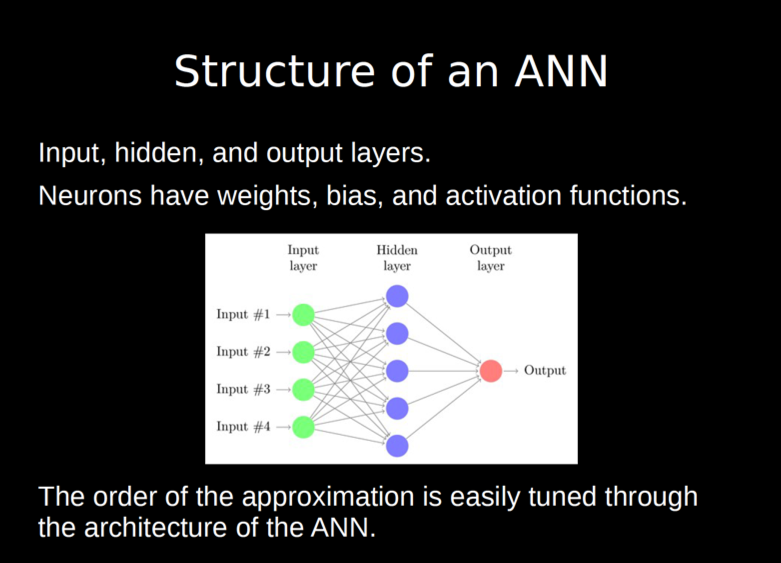
And now here is an example structure on how to predict the current financial value of a house. Notice the input variables (number of bedrooms, square footage, location, etc.), the hidden learning AI modules, and the output.

Our APC members then wanted to know how does this “learning process” take place. Chris then told us that “we fit a desired set of inputs to a corresponding set of outputs by interactively adjusting the weighted coefficients in the network.”
How large can a neural network be? That’s an interesting question for sure. The African elephant has 257 billion neurons, the human brain 86 billion, a fruit fly 135 thousand, a roundworm 302 and a sea sponge 1 neurons.
But for us developing this infrastructure, the maximum is 16 million neurons, with an average per application of less than 200.
Machine learning (ML) is already very prevalent, although we may hardly notice it. Used for spam detection, credit card fraud detection, speech recognition, face detection, investment data analysis, language recognition, medical diagnosis, and a host of other services.
MI applications are mostly written in Python, R, Matlab/Octave, and in C/C++
Mr. Cole then gave us some very good advice. If you would like to learn and develop MI applications, you should…
Brush up on your math and statistics skills
Learn to code
Understand databases, Lakes, distributed srcs
Learn data cleaning techniques
Understand how to effectively present findings
Expand your toolbox
Get involves in the data science community
… and PRACTICE, PRACTICE, PRACTICE!
He then shared the following web resources for training and more information on the subject:
Online training courses at Coursera, Udacity and fast.ai
www.machinelearningmastery.com
www.datasciencecentral.com
https://ai.googleblog.com/
www.thetalkingmachines.com
www.kaggle.com
The talk then concluded and the floor was opened for question. We thanked Chris Cole for his interesting and eye opening presentation on machine learning.
This reminds me of a quote by Ronald Coase, “if you torture the data long enough, it will confess.”
Jonah Kirszenberg, Secretary
~~~~~~~~~~~~~~~~~~~~~~~~~~~~~~~~~~~~~~~~~~~~~~~~~~~~~~~~~~~~~~~~~~~~~~~~~~~~~~~~~~~~~~~~~~~~~~~~~~~~~~~~~~~~~~~~~~~~~~~~~~~
Newsletter
Meeting Announcement: MONDAY, April 22, 2019 - TANGIER, 6:00 PM
Bruce C. Taylor, PhD, Emeritus Professor of Biomedical Engineering, the University of Akron
will be speaking on:
Mathematical and Computer Modeling of the Circulatory System
-
It wasn’t until the 1600’s that we began to understand the mechanisms that govern the operation of the heart and circulatory system. Here we are 400 years later still trying to unravel the secrets of in life and what can be done to better deal with some of life’s problems.
With the introduction of Digital Computers, in the 1950’s, mathematical and computer modeling of physiological systems came into its own as a field of Medical or Biomodeling. Although computer modeling is more readily accepted now, than in the early days, mathematical models describing the workings of the circulatory system are still in their infancy due to the complexity of the systems. But partial models, as complex as they are, are one of the primary means for understanding the science of medicine and the human body.
Biomodeling has three principal uses:
- Research
- Teaching
- Clinical Applications
This presentation, for The Akron Physics Club, will show the development of a dynamic (i.e. time varying) circulatory system model and how the resulting differential equations, representing the model, are solved. A demonstration of how the model can be used to answer “What if” questions regarding circulatory phenomena will be given.
About the Author
Bruce C. Taylor, PhD, is an Emeritus Professor in The University of Akron’s Biomedical Engineering Department from where he retired, after 30 years, in 2011. Dr. Taylor’s area of specialization was Physiological Monitoring and Medical Instrumentation. He worked closely with NASA Ames Research Center, Mt. View, California, writing computer software used to monitor the Physiological Responses of Astronauts/Cosmonauts living in a micro-gravity environment. This software was used to help train these space travelers to avoid space-motion sickness, a condition that is associated with living in a weightless environment.
Dr. Taylor received his Bachelor’s Degree in Biology from Hiram College in 1964. He then attended Kent State University for his Masters (’66) in Physiology and PhD (’71). The latter degree was combined with an engineering education from Baylor College of Medicine (’66, ’67, ’68) to provide the necessary engineering, mathematics, physics and electronics to further his career in Biomedical Engineering.
Minutes, April 22, 2019
Notes on Bruce Taylor's presentation:
Mathematical and Computer Modeling of the Circulatory System
Dr. Bruce C. Taylor thanked everyone for the opportunity to speak today…
- - - - - -- - -- - -- - -- - -- - -- - -- - -- - -- - -- - -- - -- - -- - -- - -- - -- - -- - -- - -- - -- - -- - -- - -- - -- - - - - - - -- -
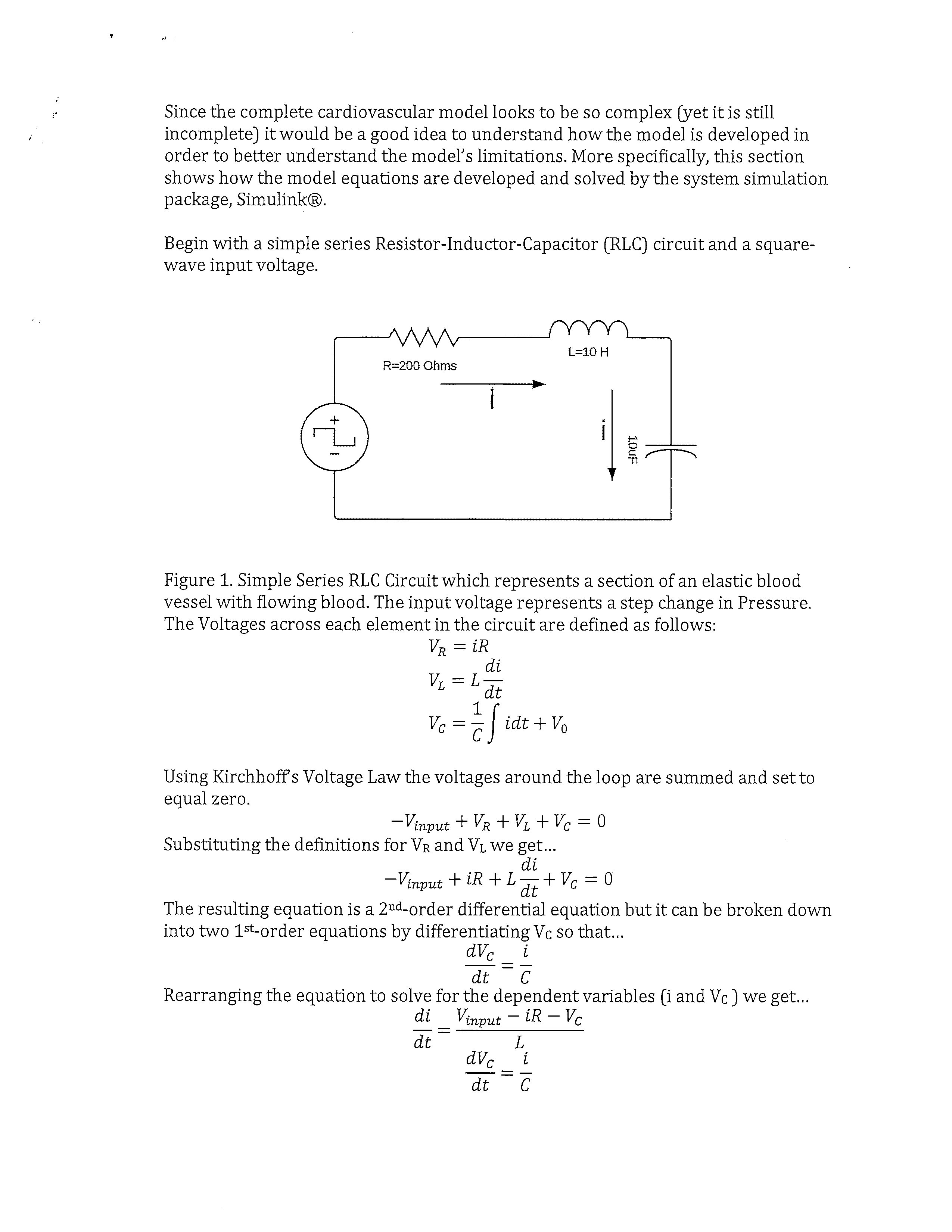
- - - - - -- - -- - -- - -- - -- - -- - -- - -- - -- - -- - -- - -- - -- - -- - -- - -- - -- - -- - -- - -- - -- - -- - -- - -- - - - - - - -- -
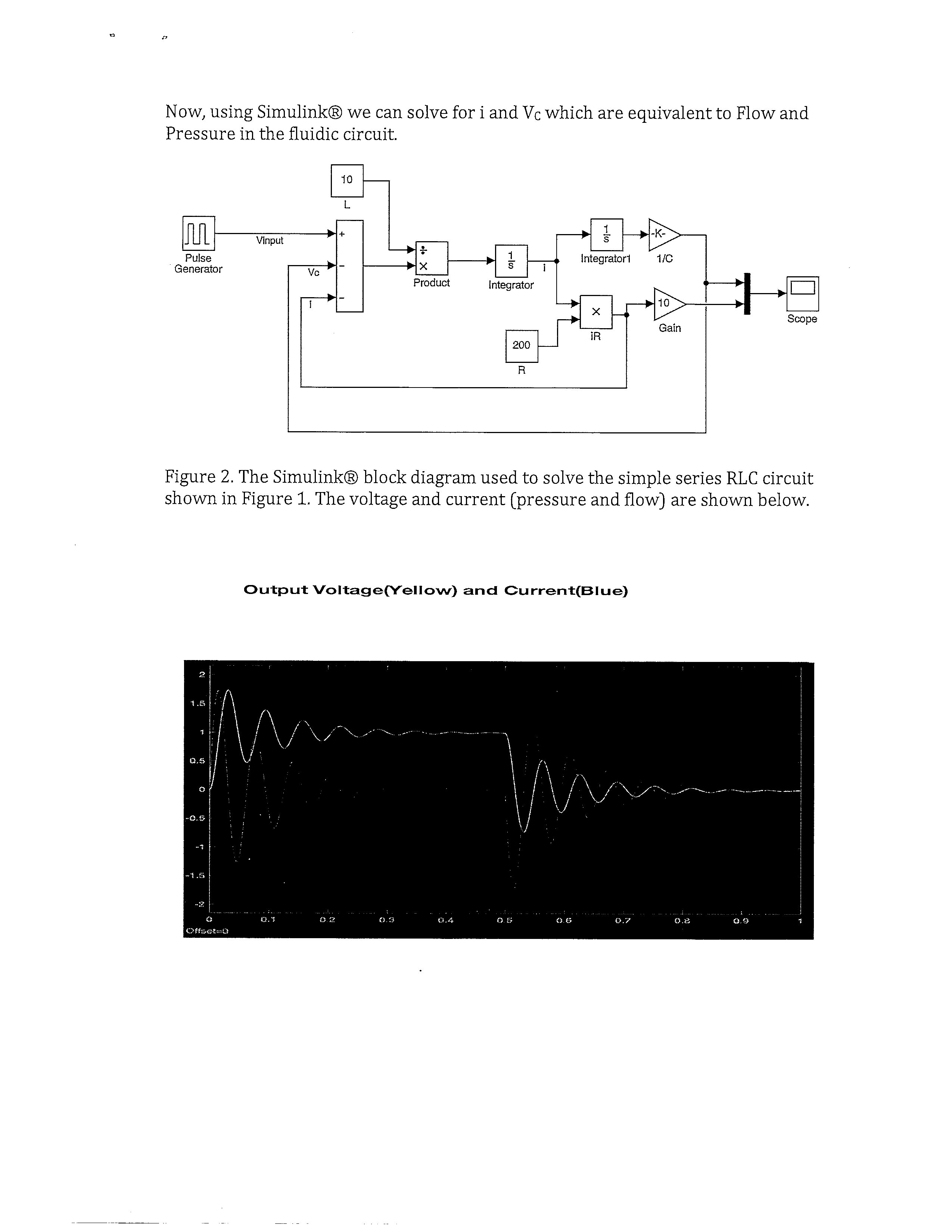
- - - - - -- - -- - -- - -- - -- - -- - -- - -- - -- - -- - -- - -- - -- - -- - -- - -- - -- - -- - -- - -- - -- - -- - -- - -- - - - - - - -- -
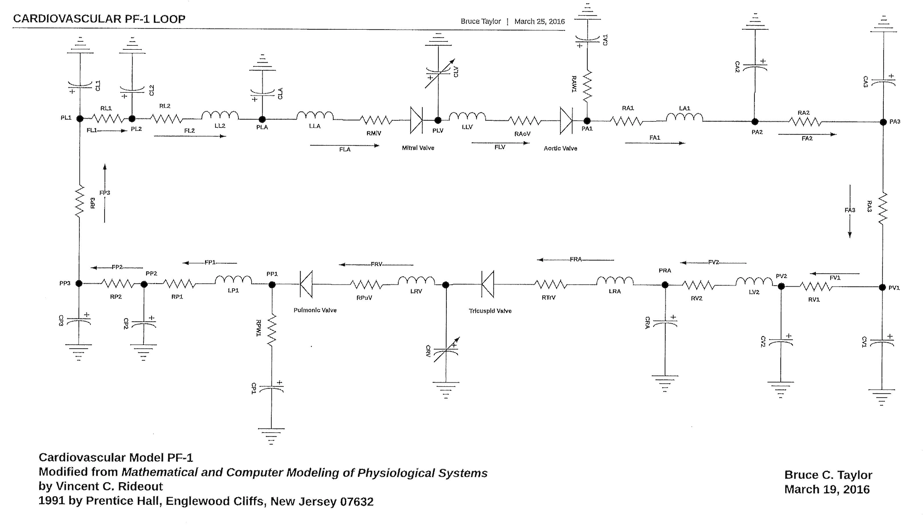
- - - - - -- - -- - -- - -- - -- - -- - -- - -- - -- - -- - -- - -- - -- - -- - -- - -- - -- - -- - -- - -- - -- - -- - -- - -- - - - - - - -- -

~~~~~~~~~~~~~~~~~~~~~~~~~~~~~~~~~~~~~~~~~~~~~~~~~~~~~~~~~~~~~~~~~~~~~~~~~~~~~~~~~~~~~~~~~~~~~~~~~~~~~~~~~~~~~~~~~~~~~~~~~~~
Newsletter
Meeting Announcement: MONDAY, June 3, 2019 - TANGIER, 6:00 PM
Bob Erdman, Akron Physics Club Chair, MS Physics from John Carroll University
will be speaking on:
Ideal Measurements vs Real Measurements
-
Abstract:
Real measurements and instruments are imperfect. Ideal sources and instruments are perfect but they do not exist. They are useful to examine measurement errors, and disobey the rule stating that “in order to make a measurement, you must disturb the system”. This discussion focuses on dc measurements but can be extended to ac measurements. This discussion will show examples of how to quantify errors based on the characteristics of the source, the connection to the measuring instrument and specifications of instruments. Emphasis will be on measurement of very small voltages, currents and resistances, and large resistances. These quantities are often encountered in experimental physics. Ways of minimizing these errors will be presented.
Bio:
Bob graduated from the Ohio State University in 1962 with a Bachelor’s degree in Electrical Engineering. He then embarked on his 40-year career with Keithley Instruments. He did his graduate work at John Carroll University, earning a Master’s degree in physics in 1970. In his career he developed dozens of sensitive and precision instruments, some with capabilities of measuring 10-17 coulombs (the charge of 60 electrons) and others that detected voltage changes of 3x10-12 volts. He was granted three patents, has written numerous articles, and has given hundreds of technical presentations all over the world on measurements of small electrical quantities. He re-wrote the Keithley Electrometer Measurements Handbook. He managed design groups, a Marketing Department, many special projects and Keithley’s business with research laboratories. He retired from full time employment in the year 2000 and had a consulting practice until 2010.
Bob has been a member of the Akron Physics Club, which he now chairs, for about 15 years. He was the Physics Club’s first representative to ACESS and was Secretary of the Physics Club for many years. He was also ACESS Secretary for many years and served as ACESS President in academic year 2016, a year in which the organization was significantly restructured. He continues to serve on the ACESS Board.
Bob has three grown children and one grandson born in 2018, Bob’s 80th year. He has enjoyed playing classical piano since the age of seven, and has played with many traditional jazz bands, including a 40-year gig at the Rusty Nail north of Kent, ending in 2011. He now teaches piano at his home in Kent.
JUNE 3 2019 MEETING NOTES:
The business meeting opened with the Treasurer’s Report: We collected $238 and owe The Tangier $240. This was updated after the meeting by Nemer as follows: Bruce Taylor gave me $20 for his dinner he missed on Monday. That takes us to one dinner we paid for. Our June meeting had a profit of $6 and $455 for a total Treasury.
John announced that a NASA Astronaut will be speaking at the Akron Public Library on June 20; the program is open to the public and an announcement will be on the website. Ernst von Meerwall, past Chair, was introduced to the group as was Noah Kerns a Marine Officer Candidate who helps Bob and Carol around their house.
Daryl Reneker, Vice Chair introduced the speaker, Bob Erdman, whose history was outlined in the announcement in this meeting. Bob had a sheet passed out to everyone correlating exponents and engineering units including extremely large and small quantities.
Bob Erdman: Ideal vs. Real Measurements
Ideal measuring instruments do not exist, but are useful to analyze measurements in complete systems consisting of a source or device under test, interconnections and measuring instruments. A simple example would be an inexpensive meter used to measure the voltage on a battery. More complex examples used in physics labs can be large complex systems connected to a measuring system.
One of the first things to consider is how good a measurement is needed. To find out if an AA battery has more than 1.2 voltage at its terminals is not a demanding measurement. In physics work more demanding measurements are often required. Once it is clarified how good a measurement is needed, then an appropriate instrument or instrumentation system must be selected that meets the requirements. Considerations include ability to measure the needed levels of voltage or other parameter, the accuracy, repeatability, cost and required skill of the user.
An ideal voltmeter does not exist, but has zero errors, infinite input resistance and no internally generated currents or voltage. A real voltmeter can be modelled as an internal ideal voltmeter which is not accessible, in series with a voltage source, with a current source, capacitance and a finite resistance across the input terminals.
An ideal ammeter has zero terminal voltage, zero internal resistance no errors, and no internally generated currents. A real ammeter consists of an inaccessible ideal ammeter in series with a resistance and voltage sources. Errors are not zero, and there are some internally generated currents. Ammeters may be a shunt ammeter, consisting of a calibrated resistance with a voltage measuring circuit across it, or a feedback ammeter consisting of an operational amplifier with a calibrated resistor between the negative input and the output, with the positive input connected to ground. In this circuit, the input is held very near ground and nearly all the current goes through the calibrated resistor. Thus the output voltage is the negative of the current being measured times the calibrated feedback resistor.

An ideal voltage source has zero internal resistance, and no errors. The voltage is maintained at the output terminals regardless of the current drawn, up to the specified current limit of the source. 4-terminal voltage sources have a separate pair of terminals to sense and control the voltage right at the load so the resistance between the supply terminals and the load does not cause an error in the voltage supplied at the load terminals. A real voltage source can be represented by a series voltage source equal to the no-load terminal voltage in series with a resistance equal to the internal resistance of the source.
An ideal current source has zero errors, and the terminal voltage is whatever is needed to cause the selected current to flow, up to the “compliance limit”, the highest voltage can appear at the terminals. A real current source can be represented by an ideal current source in parallel with the open-circuit resistance, called the Norton Equivalent circuit for a current source. Note that if the Norton equivalent current source is the Thevenin equivalent voltage source Vt divided by the Thevenin equivalent resistance Rt, then the then the short-circuit current from both circuits is Vt/Rt and the open-circuit voltage from both circuits is Vt. Thus the Norton or Thevenin equivalent circuit may be chosen to be the most convenient for a particular analysis; they are equivalent.
Like the sources and measuring instruments, interconnections are not ideal either. There is series resistance in each lead, a non-infinite resistance and a non-zero capacitance between the leads, as well is voltage generated along each lead, and current generators between the leads. These errors are not usually specified but they can be measured by just connecting the interconnect to the measuring system without involving the source. For voltage measurements, the source should be replaced by a short circuit. For current measurements, replace the current source with a shielded open circuit.
For the problem of measuring an AA battery to determine if it is over 1.2 volts, it is obvious that the supplied test leads are adequate for the measurement, and that even an inexpensive voltmeter is adequate to determine if the terminal voltage is over 1.2 V. In the physics lab, often more demanding measurements are needed, such as measuring a voltage of about 1mV to within about 3% from a 10 megohm sample. This could be for a materials study, or to determine hall coefficient of a sample for example.
3 types of voltmeters were considered for this measurement:
* A Digital Voltmeter, which has good accuracy, perhaps a few microvolts noise, 100-1000 Megohms input resistance, and typically something like a 100pA input current. It is comparatively low cost.
* A Nanovoltmeter, with similar input characteristics except voltage noise is much lower, typically tens of nanovolts, and
* An Electrometer, with similar or slightly higher voltage noise than the multimeter, input resistance of gigaohms or higher, and noise current of only femtoamps.
For each of these, we considered errors due to input resistance, noise voltage, and input current.
Errors due to: Input Resistance: Noise Voltage: Input Current:
Digital Voltmeter: 1% 0.1% ~100%
Nanovoltmeter: 1% 0.001% ~50-100%
Electrometer 0.001% ~1% 0.01%
Even though these are approximate numbers it is very clear that the Digital Voltmeter and Nanovoltmeter are not suitable for the measurement and the Electrometer is the only instrument of these three that can make the measurement at the desired error level.
Voltages and currents generated in the connection of the sample to the measuring instrument were not considered in this analysis. Voltages such as those generated by temperature gradients due to the Seebeck effect, could be a few microvolts and this would only be a few tenths of a percent error compared to the 1mv signal. Likewise, a generated current of 1picoamp flowing through the 10-megohm source resistance would develop a 10 microvolt voltage creating a 1% error.
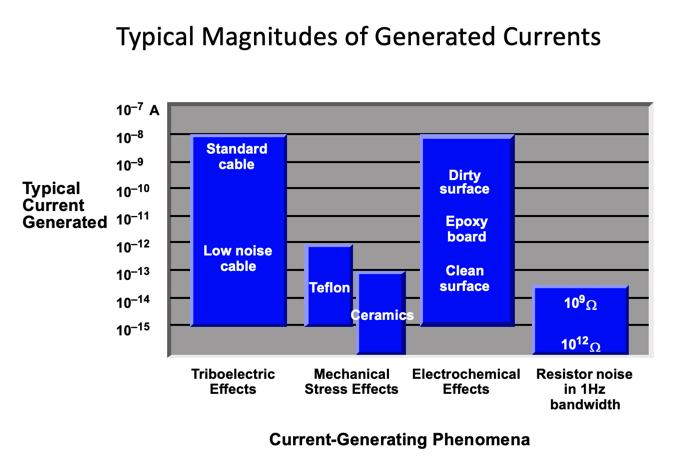
While there is no ideal instrument Bob showed an example an electrometer capable of measuring current changes below 1fA. In order to minimize currents generated by the interconnection, the input connector is a “remote head” about the size of a 1cm thick credit card, that can be located right at the source.
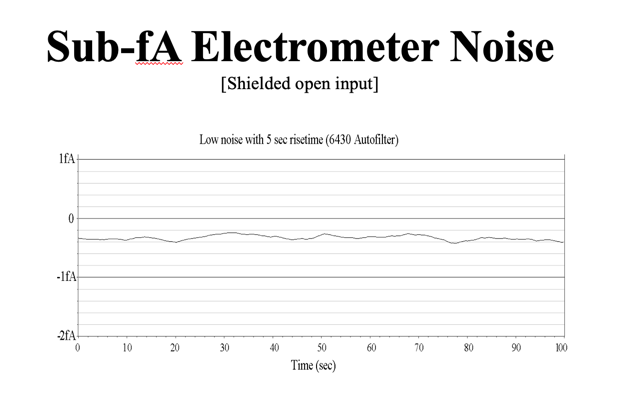
In conclusion, this method of analyzing the quality of measurement needed, selecting an appropriate measuring system, understanding the limitations of the source, and then building an interconnect that does not degrade the measurement, and measuring the errors created by the interconnect, can be successfully used to estimate and quantify errors in physics measurements and reduce these to an acceptable level.
Bob was given a round of applause and the audience asked a few questions about specific measurements which the group discussed.
Bob Erdman, APC Chair
~~~~~~~~~~~~~~~~~~~~~~~~~~~~~~~~~~~~~~~~~~~~~~~~~~~~~~~~~~~~~~~~~~~~~~~~~~~~~~~~~~~~~~~~~~~~~~~~~~~~~~~~~~~~~~~~~~~~~~~~~~~
Newsletter
Meeting Announcement: MONDAY, September 23, 2019 - TANGIER, 6:00 PM
Jonah Kirszenberg, Akron Physics Club Secretary, BA in Astronomy from Case Western Reserve University
will be speaking on:
The Flat Earth Movement: Why now, Why again?
-
Abstract:
Although the sphericity of the earth was established by Greek astronomy in the 3rd century BC, from time to time there has been a resurgence in the conspiracy myth that the earth is flat. Galileo had to contend with the Church not acknowledging the heliocentric sun/earth system, and the United Kingdom Bedford Level Experiment and Zetetic Astronomy (1838) inspired another revival. Then in 2012 a whole new generation took on that mantle and have been filling social media with misguided and scientifically incorrect videos to bolster their flat earth claims.
So why are they doing this now? What are the core beliefs and human emotional needs that they are trying to satisfy - at the expense of science, culture & humanity?
Bio:
Jonah Kirszenberg started his astronomy career while still in high school. During his senior year he lectured at the Cleveland Museum of Natural History, Ralph Mueller Observatory. During the next years while at Case Western Reserve University he continued showing the public the Sun and daytime planets at the Observatory. He also gave planetarium shows to school groups.
While earning his astronomy degree at CWRU he coauthored and published A Modern Version of the Ole Roemer Experiment in Sky & Telescope Magazine, computed satellite transit times and observing positions over the Cleveland sky, discovered a new type of variable star in the constellation Serpens, completed a senior thesis, and took a graduate level course.
During the summers of 1971 & 1972 Jonah worked at the ESSA (now National Oceanic and Atmospheric Administration) solar observatory in Boulder Colorado, observing and studying the physics of the Sun.
Then as life would have it (since having money to eat is a good thing), Jonah spent the next 30-years as a professional computer programmer/analyst/project-manager/and manager before retiring in 2015.
Jonah Kirszenberg has been a member of the Akron Physics Club, and on the Board of Trustees of the Cleveland Astronomical Society, for the past 20-years.
Since 2012 he has been debunking flat earth social media and YouTube advocates.
Minutes, September 23, 2019
Our Chair Bob Erdman called the meeting to order.
Our meeting schedule is the same as last year, with our May 2020 meeting on June 1st, due to Memorial Day.
Bob presented the slate of APC officers standing for (2019 – 2020) election. There was some brief discussion followed by a seconded motion to adopt those listed. The Club then overwhelming voted in the following officers:
|
Officers 2019 - 2020 |
|
|
Chair |
Bob Erdman |
|
Vice-Chair |
Darrell Reneker |
|
Program Chair |
Dan Galehouse |
|
Secretary |
Jonah Kirszenberg |
|
Secretary of Reservations |
Carol Gould |
|
Treasurer |
Rick Nemer |
|
Name Tag Marshall |
Carol Gould |
|
Webmaster |
Jonah Kirszenberg |
Thank you all for volunteering to serve the Club and our members.
After going many years without a need to update our Bylaws, the time had come. Proposed changes were made to better suit the current needs of the Club. Time was spent over the past year carefully considering additions and deletion from the current text. In the end the officers presented a updated version of our Bylaws to the membership for discussion and vote.
Here is the voted in document…
We welcomed guests Nora Mishey, and Richard & Nancy Whisler. Sarah Wright also attended..
Remember that EVERYONE IS ALWAYS WELCOME TO ATTEND OUR CLUB MEETINGS. But please register for each event, whether you want dinner or are just coming around 7:15pm for the lecture - so we have an accurate count for Tangiers.
Program Chair Dan Galehouse mentioned that next month we have a joint meeting with the Torch Club, the other group that meets here at the Tangiers on this same night. Joe Huber will speak about his experience living on a rubber plantation in the Philippines during World War II, and how Goodyear managed 520 square miles of rubber trees. Our November meeting will also be with the Torch Club, and Michael Fricke will speak on the Lewisite Project in Cleveland.
The meetings for January and beyond are not yet confirmed.
Treasurer Rick Nemer went over todays numbers with us. 21 people attended, with 17 having dinner. We paid $330 for dinners (as speaker and guest are free).
Our starting balance of $455 less dinner expense = $445. Of that amount $246 is held as student sponsorship from previous donations. Net loss to our whopping treasury was -$10. Since we have no dues, our bargain basement membership is EASY on the pocket book.
Secretary Jonah Kirszenberg called on Ann Ferrell. Ann addressed the group to announce the next Akron Astronomy Club meeting speaker and date. On September 27th Dr. Patrick Durrell from Youngstown State University will speak on “Studying Galaxies with the Hubble Space Telescope.”
Notes on Jonah Kirszenberg presentation:
The Flat Earth Movement: Why now, Why again?
Dan Galehouse then introduced Jonah Kirszenberg, our speaker for tonight. Dan pointed out that like many scientists, interest in the subject starts in High School. During his senior year Jonah was lecturing at the Cleveland Museum of Natural History, giving school planetarium shows and opening the Mueller Observatory 10.5 refracting telescope on weekend days for public viewing (sunspots, etc.). During college at Case Western Reserve Jonah observed eclipses of the moons of Jupiter and published “A Modern Version of the Ole Roemer Experiment,”
(Meeting notes are not available)
Jonah Kirszenberg, Secretary
~~~~~~~~~~~~~~~~~~~~~~~~~~~~~~~~~~~~~~~~~~~~~~~~~~~~~~~~~~~~~~~~~~~~~~~~~~~~~~~~~~~~~~~~~~~~~~~~~~~~~~~~~~~~~~~~~~~~~~~~~~~
Newsletter
Meeting Announcement: MONDAY, October 28, 2019 - TANGIER, 6:00 PM
Joe Huber, Goodyear Aerospace & Lockheed Martin, Engineer
will be speaking on:
The Akron's 520 sq.mi. of Rubber Plantations
-
Press Release:
Akron rubber companies at one time held 520 square miles of rubber plantations. At a joint meeting of the Akron Torch Club and the Akron Physics Club Joe Huber, Jr. who grew up on Goodyear's Philippine rubber plantation, will address the history and demise of Akron held rubber plantations.
Crude rubber is in the outer layer of many plants, and with crude oil powered the modern age of transportation and made Akron the City it became. Even with synthetic rubber, plantation crude rubber continues to play a vital role in transportation and today's life where rubber meets the road.
While Akron's plantation era has ended, in its heyday Akronites ran rubber plantations holding 10's of millions of trees on four continents with more employees that in the Akron rubber factories.
Joe Huber, who spent a career as an engineer with Goodyear Aerospace cum Lockheed Martin, will speak to the joint Torch/Physics Club gathering and guests at their October 28th dinner meeting at the Tangier Restaurant, 432 West Market Street. Torch and Physics Club are organizations of professionals who meet for dinner conversation, paper and discussion. The meeting starts at 6pm, costs $20 and is open to guests, within seating capacity, by making a reservation with J. Huber at 330-929-3959 by October 25th. Physics Club members should make reservations as they normally do.
-
Minutes, October 28, 2019
This was our first joint meeting with the Torch Club.
Torch Club President Linda Porter called the meeting to order and welcomed the Akron Physics Club brothers and sisters to the meeting. Then in good fashion, we went around table to table, everyone introducing themselves.
The Akron Physics Club was then invited to conduct their business meeting. Vice-Chair Dr. Darrell Reneker announced how pleased we are to get acquainted with the people we see going in and out of the building, and have dinner with all of you. Thank you.
Linda Porter than asked, “do you want to conduct a business meeting?” at which Dr. Reneker replied, “that is the business meeting.” And every enjoyed that comment.
Torch Club then conducted their business meeting.
Torch Club President Linda Porter then introduced tonight’s speaker.
Joe Huber of the Akron Torch Club is an Engineer, worked for Goodyear/Lockheed Martin who lived with his family on a rubber plantation. He will also cover why Akron, Ohio, was once considered to be the rubber capitol of the world.
Mr. Huber started with “for this joint meeting tonight I would like to talk about this material that is fundamental to the physics we know most about, the one most important to modern life, rubber meeting the road.”
Tree natural rubber and crude oil are the foundation for the automotive revolution and essentially modern life.
Rubber is component of thousands of type of plants and provides it with the ability to ward off herbivores, foreign insects, etc. When the plant is damaged it serves as an automatic “bandage.”
As far back as 1820 the industrial world had no use for natural rubber. But then the need for waterproofing came about. When Charles Goodyear came up with vulcanizing (a chemical process used to harden rubber) in 1839 there was growing interest. Only plant crude rubber was available then.
Akron’s history in rubber started around 1917. In the process our little town of Akron accumulated 520 sq./mi of rubber plantation. There were more people working on the plantations than working in the tire building shops. The rubber industry started here in Akron but was then exported to other places across the world.
The tragic era of wild rubber was prior to 1900. At that time wild pickers of rubber were exploited terribly. Atrocity’s and millions of death occurred to meet the growing demand for rubber which started around 1820 and lasted until about 1910. There was a real need for rubber to maintain the world that was developing at that time.
The Weeping Wood by Vicky Baum, and The Heart of Darkness by Joseph Conrad describe the terrible condition in the Amazon and Belgium Congo. King Leopold of Belgium became very wealthy due to the forced labor of the indigenous population to collect rubber.
It was plantation rubber that put an end to these atrocities. Started in Asia.
There are thousands of plants that produce rubber, but only one really good one which is called Hevea Brasiliensis. The tree from the Amazon that became the foundation for modern rubber. That occurred when Henry Wickham (explorer) in 1876 took 70,000 seeds and gave them to Q Gardens in England. For 20 years those seeds remained unused in storage at Q Gardens while the tragic deaths of rubber workers continued.

In 1896 Q Gardens finally sent seeds to British Ceylon and Malaysia where weather/conditions were ideal for Hevea Brasiliensis to grow, and so the planation harvesting business was started.
From 1910 to 1920, as more rubber came to market, there were ups and downs of the product value just like other commodities.
Winston Churchill tried to do a one country OPEC with rubber. If another country exported a lot rubber they had to pay a high tariff to England. This changed the rubber market significantly. It turned out to be a great error for England since competition plantations sprung up elsewhere. England lost their prime position as the leading rubber producer in the world.
Goodyear started their first plantation (32 sq./mi.) in Dutch Sumatra in 1926, which is where Ann Ferrell of the Akron Astronomy Club grew up. But it was the Stevenson Act that caused Herbert Hoover (later president) urged US companies to go into the rubber plantation business for themselves, to break the English monopoly on the product and stabilize prices. Then they had to wait 7 years to start get production from the planted rubber trees investment.
Goodyear also at that time bought some land in the Philippines to experiment with growing “clones of rubber” for higher yields and plantation use.
Their clones had 3 parents – the root base which produces the rubber (from 2 parents) + leaves (from another parent).
When we arrived in 1935 (for a 17 year stay) the first rubber had gone out from the plantation and the first seedlings for Central and South America has left. This meant that after 60-years the Wickham seeds were now going around the world.
Firestone went to Liberia where they leased 15,000 sq. miles where they built the largest Akron rubber plantation at Harbel (251 sq. miles planation). It was mostly destroyed during Charles Taylors revolution (remember the war diamonds?).
After the war Goodrich bought the 28 sq. mile Guthrie plantation in Liberia.
Originally trees produced 2 pounds of rubber per year. To get that 2 pounds it took 150 tapings, and each tapping called for visiting the tree twice. Today we are looking at 20 pounds per year/ per tree, and also now looking for genetic modifications which may yield 30 pounds per year.
Starting in 1896, by the year 1900 there were 10,000 trees. By 1914 there were 2.5 million trees.
Rubber was a major component of World War II armaments. A Sherman tank needed ½ ton of rubber to make, and a battle ship had 20,000 rubber parts. There was not enough rubber available for the allies, as Japan had taken over the Asian plantations. So reclamation of rubber started along with the production of synthetic rubber.
After the war demand for rubber exploded. Later grown in many places around the world, it became a commercial commodity. Finally when Goodyear held only 1% of the world wide plantation acreage, they decided to get out of that business (in the 1980’s).
A rubber plantation is a man-made rain forest.
Today there are billions of trees on plantations, on a total area larger than the state of Ohio, employing millions of workers, to provide the rubber the world needs.
Today Indonesia is the world's largest rubber producer, and Bridgestone/Firestone operates the world's largest rubber plantation in Liberia, spanning more than a million acres.
Joe Huber concluded the talk by saying that his rubber plantation in the Philippines was his home for his first 14 years.
He then got a very hearty round of applause for his detailed and in depth accounting of the worlds discovery and quest for rubber.
Jonah Kirszenberg, APC Secretary
~~~~~~~~~~~~~~~~~~~~~~~~~~~~~~~~~~~~~~~~~~~~~~~~~~~~~~~~~~~~~~~~~~~~~~~~~~~~~~~~~~~~~~~~~~~~~~~~~~~~~~~~~~~~~~~~~~~~~~~~~~~
Newsletter
Meeting Announcement: MONDAY, November 25, 2019 - TANGIER, 6:00 PM
Michael Fricke, Ph.D., Chair of the Akron American Chemical Society
will be speaking on:
The Cleveland Mousetrap
-
Abstract:
James Conant is remembered as the scientific advisor to Roosevelt during the construction of the atomic bomb. Less well known is Conant’s work during WW1. In 1918, Conant came to Ohio to build a secret factory now known as the Cleveland Mousetrap in a desperate race to counter German mustard.
About the speaker:
Michael Fricke is a PhD chemist and current chair of the Akron American Chemical Society. Dr Fricke is an expert on arsenic chemistry and discovered dimethylthioarsinic acid (DMTA) which has proven to be a key metabolite in the toxicity associated with low-level chronic arsenic consumption.
Analytical Chemistry
Synthetic Chemistry
Process Development & Manufacturing
www.olonricerca.com
Minutes, November 25, 2019
Notes on Dr. Michael Fricke's presentation:
The Cleveland Mousetrap
NOTES ON NOVEMBER 25, 2019 JOINT PHYSICS CLUB AND TORCH CLUB MEETING
About 40 people attended, roughly 2/3 from the Torch Club, 1/3 from the Physics Club. Physics Club Chair Erdman thanked the Torch Club for hosting the October meeting, and mentioned that we were happy to host this one. Program Managers from both clubs will keep in touch and we may have future joint meetings if they judge the topic would be of interest to both clubs. Everyone gave their name and stated their club affiliation. The Torch Club Chair said a few words then Chair Erdman introduced the speaker.
Michael Fricke is a PhD chemist and current chair of the Akron American Chemical Society. Dr. Fricke is an expert on arsenic chemistry and discovered dimethylthioarsinic acid (DMTA) which has proven to be a key metabolite in the toxicity associated with low-level chronic arsenic consumption.
NOTES ON DR. FRICKE’S TALK:
Elemental Arsenic was first purified in 1250AD. It was used in traditional Chinese medicine. It is found in the soil and in drinking water. Considering locations in the US, northeast Ohio is in the 90th percentile of arsenic in the soil, with over 10.4 mg/kg concentration. In Bangladesh, one in five deaths are attributed to arsenic poisoning. Arsenic gets in the ground through contaminated water and dust from rocks in the air. It accumulates in the soil and in crops, particularly rice. Most arsenic compounds are colorless, odorless and tasteless, making it difficult to detect without chemical analysis.
The Bureau of Mines was founded in 1910 to investigate toxic gases in mines. They offered their services to the Military committee of the National Research Council in 1917. Also in 1917, a weapons development and testing facility was developed at the American University, which became the American University Experiment Station. Their focus was on chemical weapons. Many prestigious universities were also involved in this effort.
Winfred Lewis was the Director of the Chemical Warfare Service at Catholic University. After many setbacks including explosions in his lab he developed a very toxic oily liquid based on previous work with organic arsenides, which became known as Lewisite, in his honor. Chemical properties are shown below.
Lewisite [From Wikipedia}
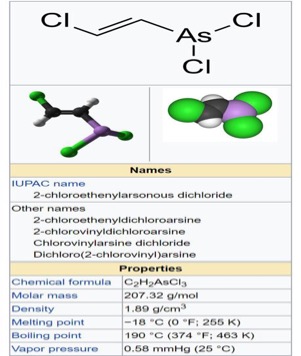
A single drop of Lewisite on the hand was said to be fatal, and it was 1000 times more toxic than the mustard gases used in Europe in World War 1. James Conant, who later worked on the atomic bomb, headed a group at American University that developed a much safer process for mass producing Lewisite. It was estimated that 3000 tons of Lewisite would be enough to cause a German surrender in the war. Conant was sent to the Cleveland area to oversee construction and operation of a production facility utilizing his method for producing Lewisite on a large scale.
Construction of the facility in Willoughby, just south of what is today the eastbound Vine St. exit from eastbound Rt. 2, began on July 20, 1918, under Conant’s direction. Barracks for 542 enlisted men and 22 officers with a mess hall and hospital were completed in November 1918 and 10 tons a day of Lewisite was being produced. Only 3 people knew the real purpose of the plant. The address was a post office box. The cover story, which was needed because of odors coming from the plant, was that a special kind of rubber was being produced there. Many of the precursors were dangerous in their own right, such as a daily delivery of 3000 tons of sulfuric acid to remove water from the purchased acetylene used in the manufacturing process.
The site was dubbed “the mousetrap” because what goes in never comes out. The soldiers represented 25% of the population of Willoughby, and would march into town daily for lunch and dinner. The November 11, 1918 armistice ended World War 1 and the need to keep Lewisite. There is a story that from someone whose father lived in Willoughby that the father was hired by the army shortly after World War I to dump drums of material from the Lewisite plant into Lake Erie.
We thanked Dr. Fricke, who answered a few questions, including one from his 10-year old son who attended. The meeting was adjourned.
Bob Erdman, APC Chair

